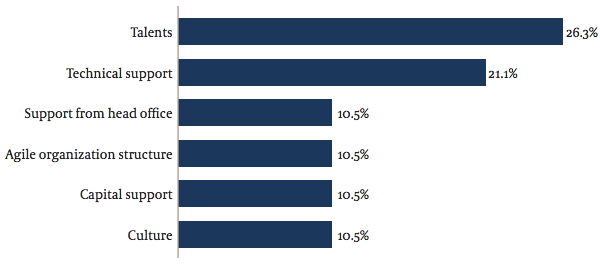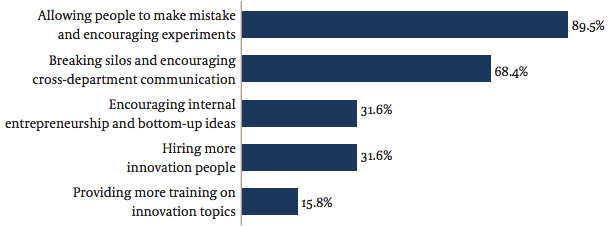China is already the world’s largest e-commerce market— and is projected to command more than half of global e-commerce revenue by 2021. With a burgeoning middle-income population, consumer spending overall is also growing rapidly, making China the second largest market after the US. That points to exciting opportunities for Chinese companies and Western multinationals alike—provided they can innovate at the speed and scale needed to meet consumers’ rapidly evolving needs and tastes, and win in the world’s most dynamic omnichannel environment.
To pinpoint what it will take to succeed, Egon Zehnder convened a forum of more than 30 China CEOs and senior executives in Shanghai in late 2017. To guide the discussion, we drew on Egon Zehnder’s Innovation Quotient (IQ) framework, developed in partnership with Professor Linda Hill of Harvard Business School. The IQ approach recognizes that today’s successful leaders must create a context within which others are willing and able to innovate—rather than simply mobilizing their teams around a vision.
We asked the participants at the forum to complete a survey, drawn from the IQ survey that we use to diagnose the level of innovation in client organizations. The results helped spotlight the state of innovation in Chinese business today, as well as the steps being taken to accelerate it.The forum was chaired by Xuemei Bennink-Bai, leader of Egon Zehnder’s consumer practice in China, and Dick Patton, former leader of Egon Zehnder's global CEO practice. We also invited four leading CEOs from diverse backgrounds to share their own experiences and insights on leading innovation.
Chinese companies, and the Chinese arms of Western businesses, are leading the way in understanding consumers’ diverse needs, rapidly creating and launching new products and services, and creating true omnichannel experiences. Yet our panelists also shared the extraordinary challenges that their organizations face in staying ahead in this fast-changing, disruptive environment. As one said: “There’s the fear that if you don’t act today, you’ll be surpassed by a new competitor tomorrow. It’s fear of the unknown, of the changes and challenges that are just around the corner.”
To master these challenges and turn China’s massive consumer opportunity into sustainable business success, companies need to build nimble, adaptive organizations—and nurture curiosity, boldness and customer-centricity among their leaders and across their teams. Our forum underlined three imperatives that have emerged from Egon Zehnder’s IQ work:
1. Invest as much time in talent and organization as you do in data and IT—and foster the leadership attributes you need to succeed
2. Shape new business models that break through bureaucracy and accelerate innovation
3. Build a culture of experimentation, risk-taking, and true engagement with the customer
Invest as much time in talent and organization as you do in data and IT
The results of our survey were revealing. Every single respondent said that innovation was “extremely important in their organizational strategy”—yet only a third said that their investments in innovation were already creating benefits for their company. For the large majority, their efforts to foster greater innovation were still a work in progress. The survey also shed light on the challenges companies must overcome if they are to become true innovators. For sure, they must get technology right if they are to win the world’s biggest e-commerce market: many cited technical support as their greatest single challenge. But talent was identified as an even greater challenge, by a significant margin (Exhibit 1).
Exhibit 1:
Organizational Capability
Currently what’s the biggest challenge on innovation in your company?

So, what are the attributes that companies need to find and foster among their talent—right up to the leadership team? The survey respondents and panelists were very clear: consumer centricity is by far the most important leadership competency needed to drive innovation. Nearly 60 percent of respondents picked this trait, compared to just 10 percent who picked data centricity as one of the top competencies required. Other priorities identified were agility and adaptability, collaboration and influencing, and market insight.
As one of our panelists said: “Real innovation is motivated not from inside your organization but by your customers and by changes in the market and in society.” Several of the panelists agreed that Chinese customers are increasingly pushy and challenging, and that they expect more from business than ever before. “Our customers want the best product, and they want it now,” said one panellist. “They also want the full service around that product, and they want you to be know their name and know what they like.” That applies equally to service industries: for example, customers no longer see hotels as merely functional places to stay, but social spaces where they seek connection and entertainment. That means that hospitality groups must instill a deeply customer-centric philosophy in their organizations, and match it with smart use of technology and customer data.
Egon Zehnder’s Dick Patton remarked: “The full development of omnichannel is demanding not only new ways of doing business, but also challenging the existing business models of many companies. Innovation in China’s dynamic market is a moving target: it can be a tremendous growth driver, or a big challenge, for both established companies and startups.”
Shape new business models that break through bureaucracy and accelerate innovation
The forum made it clear that companies must shape fundamentally new organizational approaches to innovate at the speed and scale required. We asked participants what innovation meant to them—and nearly 70 percent said it required a new business model. While many also cited “disruptive products and services”, only a few put cutting-edge technology at the top of their lists (Exhibit 2). Again, we find it remarkable that in the digital age, executives recognize that their organizations are much more powerful drivers of innovation than technology is. Our own view, expressed by Xuemei Bennink-Bai at the forum, is that: “Innovation is not only about products, it’s about your business model, your approach to the market, and how you sell—it touches on every aspect of the way you do business. True innovation requires companies to question how they should organize themselves.”
Exhibit 2:
Context
What does innovation mean to you?

What does the organization of the future look like? Xuemei Bennink-Bai told the forum that Egon Zehnder has observed its clients undertaking widespread experimentation. “The direction that most companies are going is to flatten their organizations and take out layers,” she said. “Others have been adding on new arms and capabilities. Also, many companies are experimenting with breaking down big P&L units into smaller ones, to facilitate entrepreneurship. This is particularly true of large organisations that want to let innovation flourish at all levels.”
One panelist told the forum that their company considers every team member an innovator and embraces ideas from all quarters—but then brings laser-sharp focus to executing the chosen ideas. “We force ourselves to be inclusive and to embrace all new ideas,” this panelist said. “But when we arrive at a team decision, we move unconditionally and relentlessly to implement that decision.”
Several firms have also extended their innovation business models to include “the organization beyond our own company”, in the words of one panelist. “The world has become more and more a shared economy,” this executive added. “No company can be successful without other companies’ support.”
Build a culture of experimentation, risktaking, and true engagement with the customer
In our survey, the large majority of respondents said their companies were breaking silos between departments. Many were also encouraging internal entrepreneurship and bottom-up ideas. But the most-cited step to inspire innovation, by nearly 90 percent of respondents, was “allowing people to make mistakes and encouraging experiments” (Exhibit 3).
That’s not as simple as it sounds, however. As one panelist said: “The really challenging part is how to incentivise people to take positive risks and achieve results.” To tackle that challenge, this panelist has created a separate company to build a prominent new growth business, and is treating it as a “true year-one start-up.” This CEO told the forum: “It’s a huge risk. But I truly believe that when people take risks, that’s when businesses take off in a winning way. We are incentivizing our team by creating the experience of another start-up. If it fails, they fail. If they win, we all win together as co-investors or equity holders.”
Exhibit 3:
Culture
What have you done to inspire innovation in your company?

The truth, though, is that most companies still have a long way to go in transforming their cultures to unleash innovation at pace and scale. We asked participants at the forum to describe their current company culture in regard to innovation, and barely 20 percent said it was “more like an innovative company”. A third said their culture remains that of a traditional company, and the rest said they were somewhere in between.
What practical steps can companies take to make the required cultural shift? One panelist told the forum that, for their company, a key imperative has been to “make the team more diverse and inclusive”. She added: “Here in Greater China, my 20 direct reports come from 10 different countries and areas, with different languages, cultures, and educational backgrounds. I’m a firm believer in the intersection between different cultures and experiences: that’s where true innovative ideas happen.”
Another panelist said that, to build an effective culture, companies need to clearly articulate their value systems to their employees. In fact, this leader argued that this is all the more important in China as rapid social change has left many people without a clear anchor of identity or values. “Because we lack so much in the fundamentals, sometimes companies have to make up for it. “So, here in [our firm], we have to really emphasize to our employees that this is a company where we actually treat people nicely. This is the starting point of our culture, and we have to emphasize it over and over again. We have to have a value system: in the end, that’s the only thing that will sustain this generation of Chinese start-ups as we grow up in the world.”
China’s consumer market is huge and fastgrowing, but it is also undergoing constant change and disruption. For Chinese and Western companies alike, the prize for success in this market is tremendous: not only will they build large-scale, profitable businesses in China, they will also chart the course for global success in an omnichannel world. Indeed, many international firms are already viewing China as a testing ground, not only for product innovation but also for business-model innovation.
To unlock that innovation across the organization, however, companies will need to invest heavily not just in hardware and software, but also in “heartware”: talent, leadership, and culture. As Egon Zehnder’s IQ approach shows, companies need to invest in building “collective genius” across their organizations. That requires mastery of three paradoxes: affirming both the individual and the group, balancing experimentation with a focus on results, and showing both patience and urgency. That, in turn, calls on leaders to set aside preconceived notions and foster the personal qualities of insight, engagement, curiosity and determination.
To learn more about the IQ framework, including how our proprietary diagnostic tools can help you pinpoint your organization’s own innovation readiness, please get in touch with any of the authors of this article.





